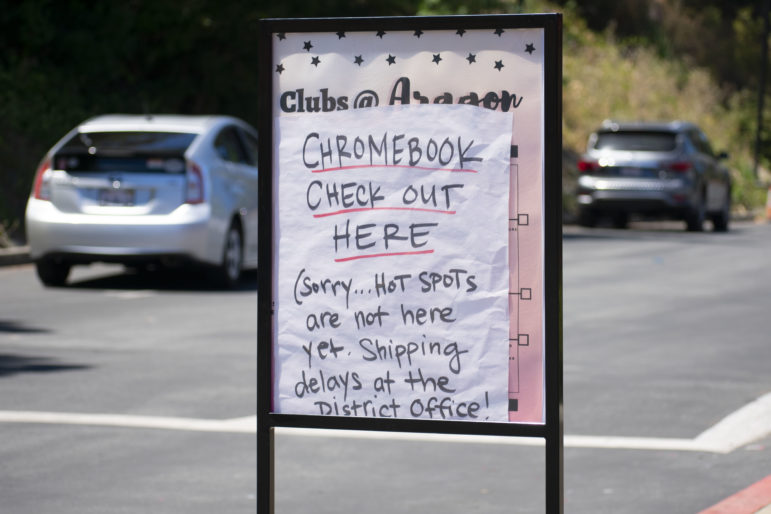

The San Mateo Union High School District is supplying Chromebooks and hot spots for all students who need them, with the hope that ample technology access will address several inequity concerns that accompany remote learning. Widespread technology will guarantee that weekly updates from site and district administrators regarding coronavirus cases, online learning or school reopening reach all families.
“Ensuring students have access to technology is important,” said Assistant Superintendent of Curriculum and Instruction Julia Kempkey. “The intent is to make sure that there is consistent access for the kids.”
As detailed in the district’s budget, the funds allocated for technology were increased by nearly $1.5 million this school year. Out of that budget, $625,000 was allocated for Chromebooks and $300,000 for hot spots.
After school shutdowns in the spring, the District distributed Chromebooks and internet hot spots to the majority of students who put in a technology request. The abrupt switch to distance learning left some students without technology for a portion of the adjustment period, so the District advised teachers against synchronous learning, as the abrupt switch to at home learning created education inequities that could prevent students from succeeding with set class or work periods.
At the end of the semester, students who would be returning in the fall kept their district provided technology through the summer, so they would have the technology at the beginning of the next school year.
Input from a District survey and a follow up site survey over the summer listed 234 Aragon students as needing hot spots for the year. As a result, the District ordered an additional 1,000 hot spots in order to support students across all campuses.
During distribution days the week before school, only Chromebooks were supplied to students, as the District’s subsequent hotspot order did not arrive until after the first day classes were in session.

“All four of the Aragon Administrators, along with our Family Engagement Coordinator Mr. Martinez, spent [Aug. 14] and the weekend calling families that had answered the District’s survey saying that they needed a hotspot … to let families know that the [d]istrict unfortunately had not received the shipment of hotspots for the start of school,” said Assistant Principal Nicole Elenz-Martin in an email. “[85%] of families we spoke to said that students would be able to connect without a problem, and the rest said that they would find another way to connect to Zoom the first week, but would really need the District Hotspot support after that.”
For students across the district, delayed internet access was confusing.
“I think [the district] handled [technology access] alright, but it was weird how they didn’t have hotspots when school first started,” said San Mateo High School junior Adam Galoul, who requested a hot spot. “I think it is absurd that some people had to start school without WiFi, especially since places, like the library, which offer[s] WiFi, [are] closed.”
On Aug. 17, the first day of school, only 10 students at Aragon did not show up for any classes, Elenz-Martin wrote in an email, based on data from the attendance office. 98.8% of Aragon students logged into Canvas on the first day, excluding full independent study and Middle College students.
“I think it is absurd that some people had to start school without WiFi”
400 hot spots were delivered to campuses on Sept. 10, bringing the district total to 1,400, as discussed during that night’s board meeting.
With many distributors on backlog, districts increasing technology purchases to adapt to potentially distanced or virtual school reopenings may not receive their orders until later in the semester..
“We have about 7,000 [Chromebooks], and we need about 9,200,” said Director of Curriculum and Assessment Brian Simmons to the Outlook over the summer. “Over the course of September, we’ll make sure that all the other students get a Chromebook.”
At Aragon, there were enough Chromebooks at the beginning of the year for all students who requested one, because of the 1:1 Chromebook Program, organized by Technology Support Specialist Malak Hojatnia and Instructional Technology Coordinator Vincent Bravo, aiming to provide every student with a district-provided device. As mentioned in the Sept. 10 educational plan update, the district now has enough Chromebooks to meet the 1:1 standard. Students who elected to not take home a Chromebook signed waivers during distribution days acknowledging they were declining offered technology.



